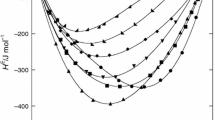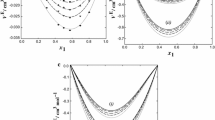Abstract
The excess molar volumes V E m and excess molar enthalpies H E m at T=298.15 K and atmospheric pressure for the binary systems {x1CH3CHClCH2Cl+x2CH3(CH2) n−1OH} (n=1 to 4) have been determined from density measurements by using a digital vibrating-tube densimeter and an isothermal calorimeter with flow-mixing cell, respectively. The 1-alkanols are methanol, ethanol, 1-propanol and 1-butanol. The V E m values of the binary mixtures increase with chain length of the 1-alkanols, resulting in entire negative V E m values for methanol, ‘S-shaped’ for ethanol, being nega- tive at low and positive at high mole fraction of 1,2-dichloropropane, and entire positive V E m values for both 1-propanol and 1- butanol. The H E m values for all systems show an endothermic effect (positive values), which exhibits a regular increase in magnitude when the number of -CH2- group in 1-alkanols is progressively increased and maximum values of H E m varying from 741 J·mol−1 (methanol) to 1,249 J·mol−1 (1-butanol) around x1=0.63−0.72. The experimental results of both H E m and V E m were fitted to Redlich-Kister equation to correlate the composition dependence. The experimental H E m data were also used to test the suitability of the Wilson, NRTL, and UNIQUAC models. The correlation of excess enthalpy data in these binary systems using UNIQUAC model provides the most appropriate results except for the system containing methanol.
Similar content being viewed by others
References
Y.W. Kim and M.G. Kim, Korean Chem. Eng. Res., 42, 426 (2004).
J.W. Kim and M.G. Kim, Korean Chem. Eng. Res., 44, 44 (2006).
D. Sen and M. G. Kim, Thermochim. Acta., 471, 20 (2008).
M. J. O’Neil, P. E. Heckelman, C. B. Koch and K. J. Roman (Eds.), Merck index, 14th ed., Merck Research Laboratories, NJ (2006).
P. Santana, J. Balseiro, J. Salgado, E. Jimenez, J. L. Legido, L. Romani and M. I. Paz-Andrade, J. Chem. Thermodyn., 31, 1329 (1999).
P. Santana, J. Balseiro, E. Jimenez, C. Franjo, J. L. Legido, L. Romani and M. I. Paz-Andrade, J. Chem. Thermodyn., 31, 547 (1999).
C. Medina, J. Fernandez, J. L. Legido and M. I. Paz-Andrade, J. Chem. Eng. Data, 47, 411 (2002).
C. Lafuente, J. Pardo, V. Rodriguez, F. M. Royo and J. S. Urieta, J. Chem. Eng. Data, 38, 554 (1993).
R. T. Morrison and R. N. Boyd, Organic chemistry, 6th ed., Prentice Hall, NJ (1992).
J. A. Riddick, W. B. Bunger and T. K. Sakano (Eds.), Organic solvents, 4th ed., Wiley-Interscience, NY (1986).
O. Redlich and A. T. Kister, Ind. Eng. Chem., 40, 345 (1948).
G. M. Wilson, J. Am. Chem. Soc., 86, 127 (1964).
H. Renon and J. M. Prausnitz, AIChE J., 14, 135 (1968).
D. S. Abrams and J. M. Prausnitz, AIChE J., 21, 116 (1975).
T. E. Daubert, R. P. Danner, H. M. Sibul and C. C. Stebbins, Physical and thermodynamic properties of pure chemicals: data compilation, part 2, Taylor and Francis, Washington, D.C. (1995).
B. E. Poling, J. M. Prausnitz and J. P. O’Connell, The properties of gases and liquids, 5th ed., McGraw-Hill, NY (2001).
M. G. Kim, S. J. Park and I. C. Hwang, Korean J. Chem. Eng., 25, 1160 (2008).
R. Tanaka, P. J. D’Arcy and G. C. Benson, Thermochim. Acta., 11, 163 (1975).
A. Chand and D.V. Fenby, J. Chem. Thermodyn., 10, 997 (1978).
M. J. Costigan, L. J. Hodges, K. N. Marsh, R. H. Stokes and C.W. Tuxford., Aust. J. Chem., 33, 2103 (1980).
L. Kirkup, Data analysis with excel, Cambridge University Press, Cambridge (2002).
J. B. Ott and J. T. Sipowska, J. Chem. Eng. Data, 41, 987 (1996).
A. Amigo, J. L. Legido, R. Bravo and M. I. Paz-Andrade, J. Chem. Thermodyn., 21, 1207 (1989).
A. Amigo, J. L. Legido, R. Bravo and M. I. Paz-Andrade, J. Chem. Thermodyn., 22, 633 (1990).
A. Amigo, J. L. Legido, R. Bravo and M. I. Paz-Andrade, J. Chem. Thermodyn., 22, 1059 (1990).
A. Amigo, R. Bravo and M. I. Paz-Andrade, J. Chem. Thermodyn., 23, 679 (1991).
Author information
Authors and Affiliations
Corresponding author
Rights and permissions
About this article
Cite this article
Sen, D., Kim, MG. Excess molar volumes and molar enthalpies in the binary mixtures of {x1CH3CHClCH2Cl+x2CH3(CH2) n−1OH} (n=1 to 4) at T=298.15K. Korean J. Chem. Eng. 26, 806–811 (2009). https://doi.org/10.1007/s11814-009-0134-6
Received:
Accepted:
Published:
Issue Date:
DOI: https://doi.org/10.1007/s11814-009-0134-6




